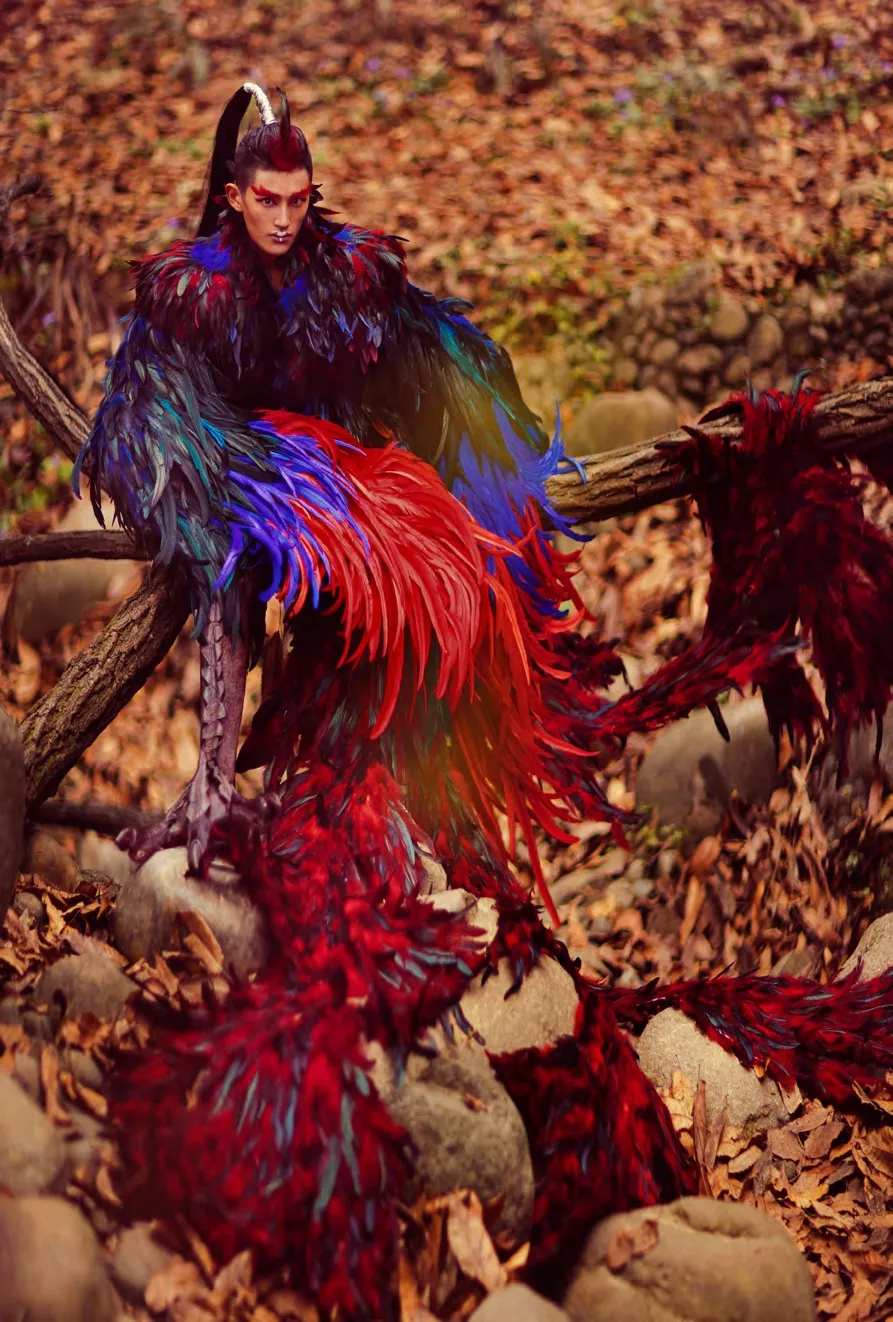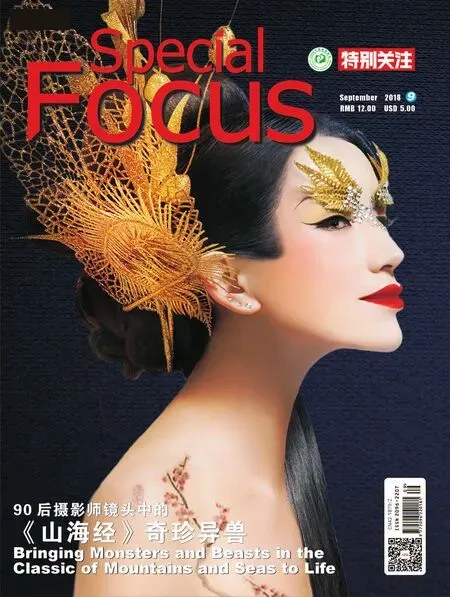Bringing Monsters and Beasts in the Classic of Mountains and Seas to Life
2018-10-15ByZengPengling
By Zeng Pengling

九尾狐:“青丘之山,有兽焉,其状如狐而九尾,其音如婴儿,能食人,食者不蛊。”——《山海经·南山经》Nine-tailed Fox: “On the Qingqiu Mountain, a fox-like cannibal with nine tails yelps like a baby.”—Classic of South Mountain, Classic of Mountains and Seas.
Note:The Classic of Mountains and Seas, a Chinese ancient literary classic, was written by the Chu (now Hubei and Hunan Provinces) people or the Bashu(now Sichuan Province and Chongqing Municipality) people from the middle and late period of the Warring States to the early Han Dynasty. The book has 22 articles in total, about 32,650 words, among which 18 articles are left now. It is divided into Classic of Zangshan (5 articles),Classic of Areas Overseas (4 articles), Classic of Regions Within the Seas (5 articles),and Classic of Great Wildness(4 articles). This major source of Chinese mythology brings together a treasure trove of rare data and colorful fiction about mythicalfigures, rituals, medicine,natural history, and ethnic peoples of the ancient world. The book preserves many ancient legends and fables, including Kuafu Running After the Sun,the Goddess Mending the Sky,Jingwei Trying to Fill the Sea, and Emperor Yu Taming the Flood.
The Classic of Mountains and Seas has extraordinary literary value and serves as a reference for the study of ancient Chinese history, geography, culture,Chinese and foreign traffic, folk customs, and mythology. The book has many versions and the earliest one is the Biography of the Classic of Mountains and Seas compiled by Guo Wei of the Jin Dynasty. Nowadays most scholars in China believe that the Classic of Mountains and Seas is a highly valuable geographical work with a long history.
The Classic of Mountains and Seas, which depicts all varieties of monsters, freaks, and folktales full of peculiarity and imagination,is the source of Romanticism in China. Tao Yuanming, a poet of the Jin Dynasty, once wrote:“While I scan the classics of the Zhou Dynasty and the charts in the Classic of Mountains and Seas, the mysteries of the universe are unveiled in front of me.Why should I be discontented?”
The legendary beasts in the ancient book, Classic of Mountains and Seas, are brought back to life by a contemporary photographer named Huanhuan.
Huanhuan, a post-90s girl who now lives in Chengdu, Sichuan Province, once worked as a model.She found that taking photos of others was more her passion than having her photo taken. Huanhuan chose to be a commercial photographer, turning herself from a model into a shooter.
As a little girl, Huanhuan had long been captivated by the fantastic ghosts and monster stories told by her grandmother. There are mysterious and rare animals, such as the bewitching fox with nine tails,the mermaid weeping pearl-tears, and the fl yingfish with long wings. When Huanhuan grew up, she came across the Classic of Mountains and Seas and was obsessed with this book. Each time reading it, shefinds herself touring in the mysteries that she always dreamed about in her childhood.

乘黄 焕焕/摄 Shenghuang by Huanhuan
After Huanhuan had been working as a photographer for some time, an idea flashed to her mind: why not recover and represent the rare animals in the Classic of Mountains and Seas through the camera. Huanhuan immediately took action. Since 2017, Huanhuan has designed and completed more than a dozen photo series that feature the beasts and monsters from the Classic of Mountains and Seas. The fantasy world narrated in the ancient book has been restored through the camera lens of Huanhuan. The various beasts recreated by Huanhuan are full of spirituality,or are glamorous and fascinating,or savvy and enchanting. Behind these photographic works of distinct personal style is Huanhuan’s relentless pursuit of aesthetic perfection, which is almost nitpicking.

《山海经》 Classic of Mountains and Seas

如魮之鱼:“滥水出于其西,西流注于汉水,多如魮之鱼,其状如覆铫,鸟首而鱼翼鱼尾,音如磬石之声,是生珠玉。”——《山海经·西山经》“The Lan River is sourced from the west and flows westward into the Han River. There are many rhodeus-like fish in the water and looks like the inverted spear, but with the bird’s head and the fish’s fins and tail. The sound of this fish is like tapping the monolith and can spit out the jade.”—Classic of West Mountain, Classic of Mountains and Seas.

毕方:“一足,赤文青质而白喙,名曰毕方。其鸣自呼也,见则邑有譌火。”——《山海经·西山经》Bifang: “There is an animal called bifang, which has red patterns, dark feather and white beak. Its singing corresponds with the name bifang. The presence of bifang gives promise of blaze in cities.” —Classic of West Mountains, Classic of Mountains and Seas.
For each shooting, preparation is always extremely laborand resource-intensive. First,Huanhuan chooses a subject—a kind of rare beast in the Classic of Mountains and Seas. Then she reads all the materials she can find about it to obtain general information of its image,characteristics, and living environment. Then, she finishes the designing job. After that, she makes clothing and accessories,which is one of the most difficult parts of pre-production. For instance, the feather cloth of the bird Bifang was glued by hand,each feather one by one, by Huanhuan. At least a few all night studio sessions are a “common occurrence” for each photo series.Another example is her phoenix photo. The flamboyant phoenix garment was made up of 7,000 peacock feathers, which took three full days to create. Every day Huanhuan and her team worked from daybreak to the early morning hours. “My back is barely straight,” said Huanhuan. As for some corners and scales, the materials bought from the market can hardly match the charm of the legendary beasts. In order to perfectly present her philosophy,Huanhuan sometimes resorts to high technology. For example, the horns of her Shenghuang were made using a 3D printer after several trial printings. Above all,Huanhuan does not care how hard the whole process is, but just concentrates on each and every detail in her works.

鲛人:“氐人国在建木西,其为人人面而鱼身,无足”——《山海经·海内南经》Mermaid: “The kingdom of Diren lies west of Jianmu. Its people all have a human face and a fish’s body and they are without feet.”—Classic of Areas within the Seas:South, Classic of Mountains and Seas.
After preparing the clothing and accessories, Huanhuan has to choose the proper environment for shooting. She aims tofind and restore the natural environment described in the book. For this reason, she goes to various places,such as mountains, lakes, and deserts to search for the most ideal and natural background. For example, when shooting the series of the Nine-Tailed Fox and South Sea Butterfly, Huanhuan flew to the Gobi Desert in Dunhuang in Northwest China.
However, the various uncertainties in the process add to the difficulty of shooting. In July of 2017, when Huanhuan took her first shots of the series of “Sheng huang—Classic of Mountains and Seas” in Dujiangyan, Sichuan, a surprising downpour forced them to give up the scene, despite the placid river being perfect for the shoot just a few hours prior. What’s more, the cosmetic bag fell into the water and was washed away.The heavy rain caused the river to soar, and Huanhuan was trapped in the river. Fortunately,Huanhuan escaped the danger and completed the shoot. When it comes to this shooting, Huanhuan still feels regret that they had to redo it, for the once clean river had become muddy during the rainfall.
Huanhuan’s photographic works are full of her personal style: bizarre and enchanting, but full of reasonable imagination.Since Huanhuan is fascinated by Chinese traditional culture, she hopes to let more people know about the charming legendary animals and interesting Chinese myths in her own way—through photography.
链接:《山海经》是一部中国古代志怪典籍,大体是战国中后期到汉代初中期的楚人或巴蜀人所作。《山海经》全书原共22篇,约32650字,现存18篇,分《藏山经》5篇、《海外经》4篇、《海内经》5篇、《大荒经》4篇,主要内容是地理知识,包括山川、道里、民族、物产、药物、祭祀、巫医等。书中还保存了夸父逐日、女娲补天、精卫填海、大禹治水等脍炙人口的远古神话传说和寓言故事。
《山海经》具有非凡的文献价值,对中国古代历史、地理、文化、中外交通、民俗、神话等方面的研究,均有重要参考意义。《山海经》版本复杂,现可见最早版本为晋代郭璞所辑《山海经传》。对于《山海经》内容性质,现中国大多数学者认为,《山海经》是一部早期的、具有很高价值的地理著作。
中国志怪古籍《山海经》中记载了大量古代怪人、怪事、怪物,全书充满想象,极尽古怪,却又奇特浪漫,引人入胜。陶渊明《读山海经》诗云:“泛览周王典,流观山海图。俯仰终宇宙,不乐复何如?”
古籍《山海经》中的奇珍异兽在一位90后摄影师的镜头中“活”了过来。
焕焕,90后成都女孩,曾被摄影师挑中做模特,但她十分热爱摄影,钟情于摄影创作,于是,她从“镜中人”转身成为“掌镜人”——一名商业摄影师。在一方镜头之中,尽情演绎、拍摄自己心中的故事。
焕焕自小听奶奶讲的鬼怪故事中,九只尾巴的狐狸、泪泣珍珠的鲛人、长翅膀的鱼,这些神秘奇特的异兽深深吸引着她。长大后接触到《山海经》,焕焕更是痴迷于这部古籍,每每翻读,都仿佛置身于儿时梦寐以求的秘境。
从事摄影一段时间后,焕焕灵光一现,能不能将《山海经》中的奇珍异兽复原拍摄出来呢?焕焕立即付诸行动。自2017年以来,焕焕已创作完成十几组《山海经》异兽系列摄影作品。《山海经》里的奇幻世界,在焕焕的镜头下复原了,各色异兽充满灵性,或妖艳动人,或诡谲惑人,这一张张特色鲜明的摄影作品背后,是焕焕对摄影、对美近乎吹毛求疵的苛刻与执著。
每次拍摄,准备工作都极为耗费人力物力。首先,确定拍摄对象——《山海经》中的一种异兽,然后翻阅大量资料,了解异兽形象、特性、生活环境,再进行造型设计。之后便是制作服饰和饰品,这是准备工作中的难题之一。毕方鸟的羽衣,所有羽毛都是焕焕一根一根粘上去的,连着几个通宵是“家常便饭”。拍摄凤凰时,这件繁复华丽的凤凰衣是由七千根孔雀羽毛粘合而成,焕焕制作了整整三天,每天从睁眼忙到次日凌晨,“腰都直不起来了。”至于有些犄角鳞爪,市面很难买到能体现神韵的材料,为了完美呈现心中构想,焕焕有时要借助“黑科技”。譬如乘黄身上的犄角,焕焕采用3D打印,反复尝试,多次打印,最终达到理想的形态要求。虽费时费力,但焕焕不想让自己的作品留有缺憾。
解决服装饰品难题之后,还需选择合适的拍摄环境。焕焕尽量还原《山海经》书中所描述的自然环境,为此她辗转各地,踏寻符合拍摄要求的山川湖海。拍摄《九尾狐》和《南海蝴蝶》时,她千里迢迢飞去了敦煌戈壁。而拍摄过程中不时出现的各种不确定因素更是给拍摄增添重重困难。2017年7月,焕焕拍摄《山海经》系列第一组作品《乘黄》,场景选在都江堰。拍摄当日,天公不作美,突降暴雨,化妆袋落入水中被冲走,而暴雨使河水猛涨,焕焕被困河中,进退两难。费劲周折后,终于有惊无险地完成了此次拍摄。但谈起此次拍摄,焕焕不无遗憾,因为原定的清澈河水变得浑浊不堪,只得弃用。
焕焕的作品极具个人风格:诡谲、妖艳、充满了合理的想象。她醉心于充满魅力的中国传统文化,希望能用自己的方式——摄影,让更多的人知道中国有趣的神兽和神话故事。
